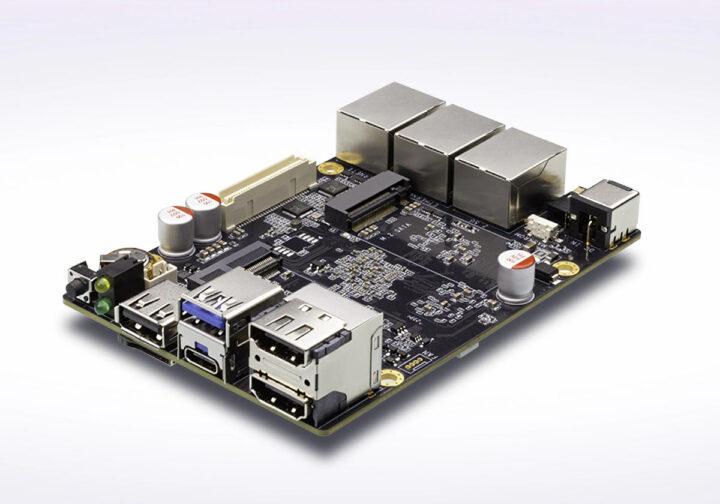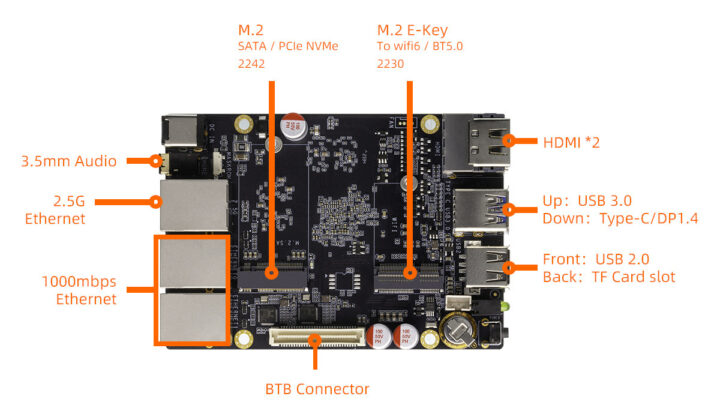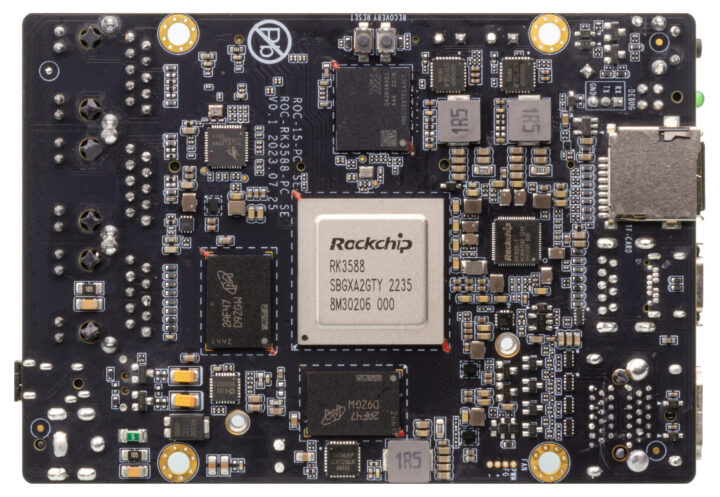Firefly ROC-RK3588-RT is a Rockchip RK3588(J) SBC suitable for networking applications such as routers and firewalls thanks to one 2.5GbE port and two gigabit Ethernet ports and available in both commercial and industrial temperature grades.
But the board is likely to be used for more complex workloads since it also comes with three video output interfaces (2x HDMI and USB-C DisplayPort), M.2 sockets for a SATA or NVMe SSD, a WiFi 6/Bluetooth 5.2 module, a 6 TOPS NPU embedded in the Rockchip processor, and a (non-standard) expansion connector with PCIe Gen 3 and other interfaces.
Firefly ROC-RK3588-RT specifications:
- SoC (one or the other)
- Rockchip RK3588 octa-core processor with
- Rockchip RK3588J – Same as above but the Cortex-A76 cores are up to 2.2 GHz for the industrial temperature range
- System Memory – 4GB, 8GB, 16GB, or 32GB LPDDR4/LPDDR4x/LPDDR5
- Storage
- 32GB, 64GB, or 128GB eMMC flash
- M.2 SATA / PCIe 2242 NVMe SSD
- MicroSD card slot
- Video Output
- HDMI 2.1 up to 8Kp60
- HDMI 2.0 up to 4Kp60
- USB-C port for DisplayPort 1.4 up to 8Kp30
- Audio – 3.5mm audio jack, digital audio via HDMI
- Networking
- 2.5GbE RJ45 ports
- 2x gigabit Ethernet RJ45 ports
- Optional WiFi 6 and Bluetooth 5.0 via M.2 E-Key 2230 socket
- USB – 1x USB 3.0 port (up to 1A), 1x USB 2.0 port (up to 500mA), 1x USB-C 3.0 OTG port with DisplayPort Alt mode
- Expansion
- M.2 SATA/PCIe 2242 socket for SSD
- M.2 E-Key 2230 socket for WiFI and Bluetooth module
- 60-pin “BTB” connector with 2x 4-lane PCIe 3.0, 2x UART, 1x USB 2.0, 1x CAN bus, 1x SARADC, GPIOs
- PCIe configurations:
- 1x 4-lane PCIe 3.0 (RC (Root Complex) or EP (End Point)) or
- 1x 2-lane PCIe3.0 (RC or EP) + 1x 2-lane PCIe 3.0 (RC) or
- 1x 2-lane PCIe 3.0 (RC or EP) + 1x 1-lane PCIe 3.0 (RC) or
- 4x 1-lane PCIe 3.0 (RC)
- PCIe configurations:
- Power Supply – 12V DC via 5.5/2.1mm power barrel jack
- Dimensions – 108.48 x 74.98mm
- Temperature Range
- Commercial: -20°C to +60°C (RK3588)
- Industrial: -40°C to 85°C (RK3588J)
- Humidity – 10% to 90% RH non-condensing
The board ships with Android 12 by default, which feels like an odd choice of a board with networking capabilities, but the company also offers Ubuntu 20.04 and Debian 11 images for the board, as well as corresponding Android and Linux SDKs. Documentation to get started can be found in the wiki and builds upon their earlier Rockchip RK3588(S) boards so it’s quite detailed.
Firefly expects the ROC-RK3588-RT to power Arm PCs, mini PCs, NAS, edge computing systems, cloud servers, smart NVRs, and industrial control systems which may benefit from multiple Ethernet interfaces. The company is selling the board for $229 with 8GB RAM and 64GB eMMC flash, a 12V/2A power adapter, and a USB-A to USB-C cable. Additional information may be found on the product page.

Jean-Luc started CNX Software in 2010 as a part-time endeavor, before quitting his job as a software engineering manager, and starting to write daily news, and reviews full time later in 2011.
Support CNX Software! Donate via cryptocurrencies, become a Patron on Patreon, or purchase goods on Amazon or Aliexpress








That capacitor blocks the use of a 2280 NVME.
Shame.
M.2 ports should have been rotated 90° so that longer models could fit. Also, the ports arrangement is strange. Putting the HDMI on the front prevents this device from becoming a small PC just because there are long fat permanent cables on both sides. I know that there wasn’t any room on the other side, but it’s surprising. Or maybe they want it to be a server and considered that HDMI is only plugged when needed, on the front (i.e. a USB-HDMI dongle). In this case I’d understand.
I was also wondering what the expected useage of this board was. Strange mix of I/O.
I will have to give them credit for the 12V barrel jack, though. Way better than a silly 5V USB connection any day.
for 229$ + shipping you can buy a multi port i3 x64 appliance – probably will drain more power but will definitely outperform rk3588
Firefly devices are always expensive when they’re released, I guess they’re mostly used as reference platforms by developers or are embedded in small series where this is not a problem.
A sodimm slot wouldve been appreciated!
Still missing feature from thoses arm board
Agreed. Apparently one reason is that LPDDRx is not compatible with SODIMM. But if the chips do also support DDRx, SODIMM would work. After all it’s not a problem on server boards (my mcbin and lx2k take regular DIMM and SODIMM).
> But if the chips do also support DDRx, SODIMM would work
The usual SoCs lack the data lines to be able to query the SPD EEPROM on (SO-)DIMMs and as such no way to determine the DIMM’s timings. Also on such a DIMM eight modules are used but DDR capable SoCs like RK3399 for example only allow to address four.
And while LPCAMM (LPDDR in sockets) might become a thing in the future the same problems might apply there too?
Querying SPD is trivial, it’s only I2C, it could even be bitbanged if needed.
Regarding the limit on the number of chips, where would the limit come from ? The fan-out on address and control lines maybe ? If so, most likely it’s easily addressed using an external line driver.
> Querying SPD is trivial, it’s only I2C, it could even be bitbanged if needed.
Sure, a device maker could do it and on those rare SoCs where DRAM initialization is open source, also code a driver. But usually there’s a BLOB doing DRAM initialization, the SoC maker doesn’t care and device makers only adjust a reference design?
That’s a good point indeed.
[ if it gets a stacked SoC&memory combination, likely a SoM, that could be interesting being connected to peripherals with a new standardized (Interconnect, PCIe or DMA network etc.) connector with high bandwidth/low latency
add memory, get more cores with that (scalable with top line/middle class/budget cores, but sufficient RAM on upgrading (varying, LPDDR5x(next?) ) carrier boards, depending on use case ]